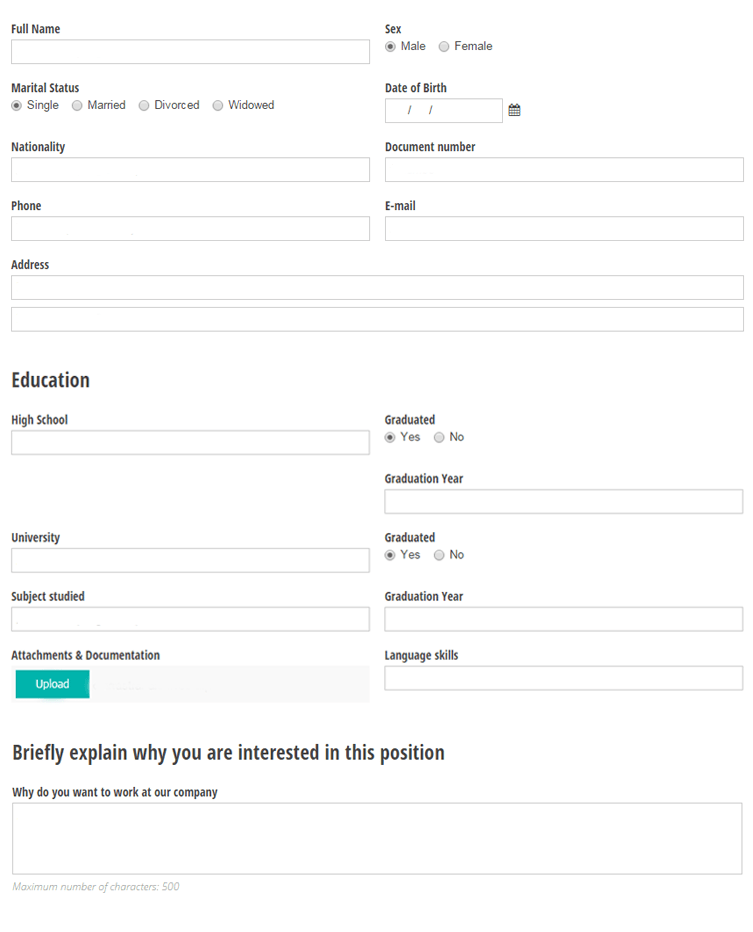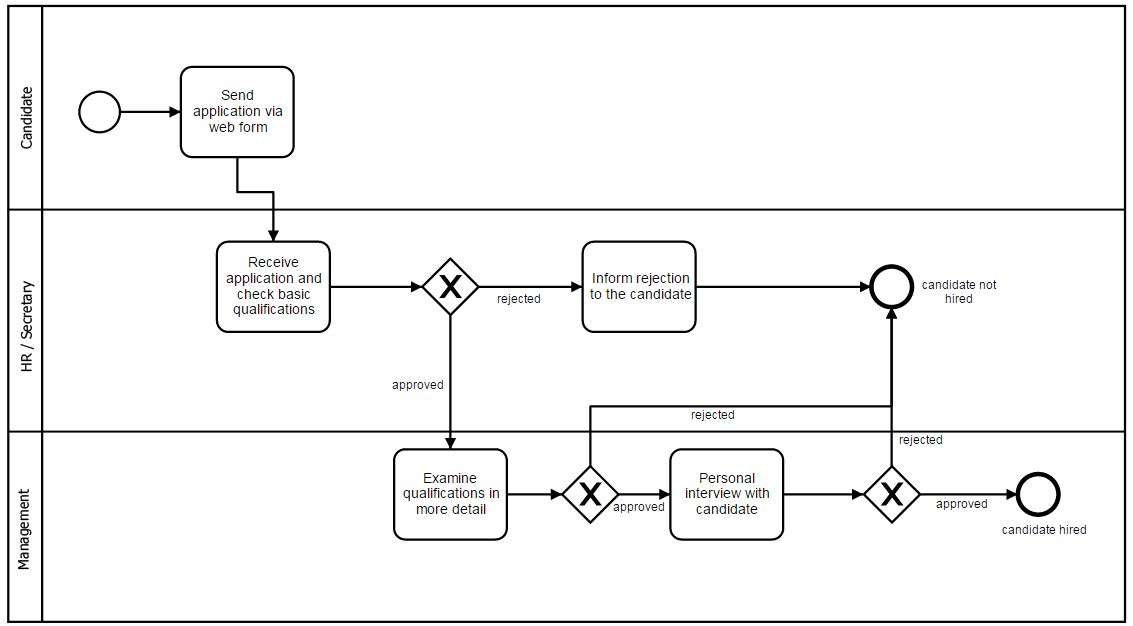Recruitment process in a Small and Medium Enterprise
In an SME nothing is more important than having a committed team with a set of skills and attitudes needed to improve the business. All mistakes made during a recruitment process have serious consequences: a bad working environment, customer dissatisfaction and even eventual bankruptcy of the SME. That’s why the Recruitment Process Automation is so important.
Unfortunately, SMEs don’t usually have the resources to hire consulting firms or specialized professionals to fill the vacancy with the right profile. Therefore, SME owners themselves are often in charge of this responsibility.
In this post, we want to cover the fundamental aspects of a recruitment process in an SME in order to minimize possible errors. We will cover:
- The profile description
- The use of BPM tools, which can help you improve the recruitment process a lot with minimum investment
- The personal interview, including a set of essential questions to ask the candidate
- How to generate a database of applicants
- Measuring conversion rates between applicants/chosen candidates
As we usually do, we will present this content in a very brief, specific way, ready to use in any SME because we know your time is precious.
Defining the profile of the candidate
Clearly, this is the first step, but sometimes it isn’t properly done. It is imperative that you dedicate 15 minutes to write down the desired profile. You don’t have to do it with much formality or detail, but you should at least define:
- The amount of training and experience that is required for the job
- Which personal skills are required? Will the employee work by himself or be part of a team?
Depending on the level of formalism required, you can complete a sheet for each candidate. A possible sheet would be the following:
 Recruitment Form
Recruitment Form
This form is essential since it enables receiving the application directly via the web. Therefore, the candidate himself enters the data, simplifying your job.
It should include all relevant information. It is important to include only what is absolutely necessary, otherwise complete it would be too demanding and we might discourage good candidates.
A recommended idea is to include a compulsory field (limited to 500 characters) for the candidate to explain why they want to work in our company. That way we can also evaluate their writing skills and motivation.
The following is an example of a basic form:
Using BPM for Recruitment Process Automation
Flokzu will greatly facilitate the selection process. The application of the candidate will go through an automated process, ensuring no delays or errors that may misplace information. It is a great support for the SME recruiter, who probably has little time to evaluate dozens (or more) of resumes and can’t make any mistakes. The cost of a BPM tool can be a problem, but there are some BPMS that are specially designed for small businesses (more information here). A BPM tool will:
- Facilitate the first revision of the application. You can define stages and actors that work on each stage, approving or rejecting an application. Again, it is important to do this quickly and add relevant comments.
- Automatically generate alerts if the process is delayed at any stage. Good candidates (the ones we want for the job) valued agile process.
We designed an example of a typical process that ensures receiving the applications and reviewing them appropriately:
Recruitment processes can be very complex. We strongly recommend starting with a simple representation and adding only the steps that are absolutely necessary.
The diagrammed example (using BPMN notation) is initiated by the web form completed by the applicant. There are other application options (via mail, email, telephone) but the great advantage of this method is that it automatically starts the next stage of the process.
The job interview: essential questions for the candidate
The interview is a key element in the recruitment process. Although it may be tedious, we recommend that the CEO conducts the interview himself. At the end of the day, it’s your company and the future of it will depend on how well you hire your employees. Therefore, the time required to do so is a necessary investment. If a process involves too many candidates, it is possible to conduct an initial interview as a “filter”.
The interview should not be a superficial conversation; otherwise, we will fail to determine the personality of the applicant or his/her ability to work. If you really want to ensure a good recruitment process, make sure to recreate real situations to see how the candidate faces problems under pressure. It is also crucial achieving a good environment for the candidate to feel comfortable and open up.
First stage of the interview
This stage covers the beginning of the interview, where generic issues will be discussed to establish the desired climate. The length should not exceed 5 minutes. The main objective is to start the conversation so that the candidate feels comfortable and is sincere. Make sure to be friendly. Two main topics should be discussed: description of the company and of the desired profile.
Company Description
- Start with something personal, an anecdote or a story for the applicant to distend.
- Discuss professional growth: Make him/her feel “part of the company”.
- Highlight the high points of the enterprise: working environment, professional development, etc.
Profile Description Search
- Job Title: basic functions and job level.
- Responsibilities, tasks of the position.
- Context: business and organizational culture, team and collaborative work.
Second part of the interview
The goal of this stage is to have a real conversation, about 25 minutes long, where you can sense personal and professional characteristics of the individual. To do this, make sure to ask open questions.
This is our set of essential questions and the information received from their answers:
- How did you hear about our company? What was your first impression of the company? You know what we do?
Evaluate motivation, energy, and interest. Did the candidate search for any extra information?
- How did you hear about our company? What was your first impression of the company? You know what we do?
- What was the last interesting project you were involved in? Was it a group project? Were you the leader? Where did you failed?
Evaluate analytical and creative abilities, self-criticism, passion, knowledge, humility, learning ability.
- What was the last interesting project you were involved in? Was it a group project? Were you the leader? Where did you failed?
- How many golf balls would fit inside a car?
Evaluate the ability to face unexpected situations, and control it. The answer itself is not important, but rather how the candidate behaves in such situations.
- How many golf balls would fit inside a car?
- What things did you dislike about your previous job?
Evaluate interests, goals, sincerity.
Note: In all of these questions, you should never stick to the first answer, which is usually the “appropriate” one. It is important to get to the details. Not because of the details in itself, but because it will show you what the substance of the applicant is and if the profile matches our team.
Creating a database
One of the main advantages of using a BPM tool for your recruitment process is the creation of a database. Automating the process enables you to store the information (both forms and comments) very quickly and efficiently. A database simplifies all future recruitment processes because:
- It allows you to review previous applications that were interesting. That’s why it is essential to identify the attractive profiles during the process.
- File all documentation regarding the process, the results of the interview, the profile sheet, etc.
- Measure the volume of applications to assess the effectiveness of the recruitment process.
- Be objective about the applicants. Avoid “first impressions” and ensure that the evaluators support their decisions with a reasonable explanation.
Measure conversion rates between applicants / interviewed candidates / chosen candidate
By automating the recruitment process, we can analyze how many applications we received for each position. We can establish a relationship between the evaluated profiles and successful hires. This is critical because:
- If we receive many applications and only a few make it to the interview stage, it means that the job description has been too wide. We are losing time evaluating profiles that do not fit.
- If we receive very few applications, the description is probably too specific. This is the worst scenario possible, since we will not fill the vacancy.
- If we interview a great number of candidates and discard most of them, the pre-filter was too lax.
- If we “like” all candidates, it means that the interview was too superficial.
There is no universal rule, but a good reference would be 50/20/10: 50% of applicants pass onto the next stage, 20% are interviewed and 10% reaches the final stage of the recruitment process.
You can also schedule a work session here to model a real-life process in your organization together



































